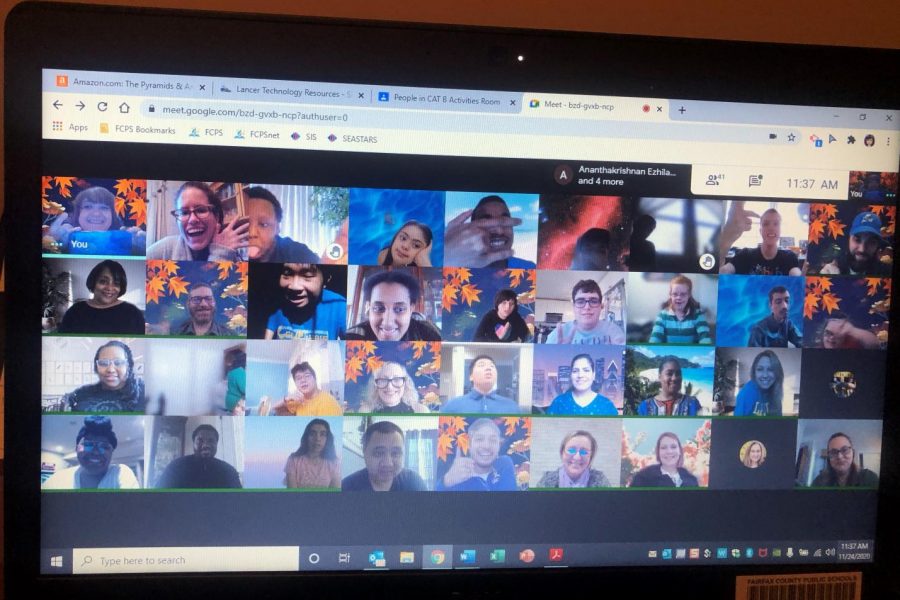Listening to teachers who have been in hybrid the longest
As FCPS gradually returned to in-person instruction, some ESOL and Special Education teachers have been teaching hybrid since the fall.
Ms. Petty and her students, captured within a Google Meet, alternate between online and in-person instruction.
March 16, 2021
The 2020-2021 school year has been hectic for both teachers and students. Each individual had to adjust to a new medium of learning. As students, some of us faced struggles such as not grasping content as effectively, Wi-Fi connectivity issues, an overwhelming workload, and staying attentive during class. Yet we don’t get much insight into how teachers are doing or what they think about virtual vs. in person school.
As many of us have witnessed, returning back to school has been a stop and start effort. FCPS implemented a gradual roll out of a hybrid classroom model. Two weeks ago, seniors and freshmen returned the building, and juniors and sophomores returned last week. As more students return to the building for in-person classes, the opinion of our teachers matters most.
No one at Lewis understands the challenges of teaching hybrid classes better than the multiple disabilities/Cat-B teachers, who have been working in-person with students since October.
CAT-B department chair Daryl Byrom provides insight into what he thinks the advantages are to being back in the building.
“It is important for the students to be with their peers to provide needed social interaction. Most students want to be with their friends and socialize and have people their own age to converse with. It is very likely that students are getting bored at home and although they are seeing their friends and classmates on the computer screen, it just isn’t the same thing as seeing them in person and having that togetherness you just can’t get in the virtual setting,” Byrom said.
Byrom makes a critical point about how some students have unique circumstances at home, stating that some families don’t have the resources to provide effective child care throughout the school day.
“Often, an older sibling is tasked with the childcare obligations. This can also present many problems such as taking that student away from their instruction, study time, etc. In addition, [in distance learning] parents are often asked to perform many of the tasks and duties the classroom teacher would normally do,” Byrom said.
Multiple disabilities teacher Charlotte Petty, actively involved in the Lewis community as sponsor for the class of 2021 and Diverse Dance Club and Unified Special Olympics Coach, saw the one-on-one support she can now offer her students as the major advantage of being in-person. Petty also observed the psychological benefits of in-person instruction for her students.
“The majority of my students that returned to in-person learning came back for the mental aspect. One student said that he needed to separate his home and work environments for his sanity, and I totally get that. Most people, whether they have a disability or not, whether they realize it or not, need routines. A sense of routine has been a huge advantage for being back in person,” Petty said.
However Petty is concerned about Lewis students following the rules of masking and social-distancing when the larger population returns to the building.
“I was in the checkout line at Barnes & Noble’s right before Christmas, and there were three Lewis HS students standing right up on the people in front of them. When the cashier asked them to stand on the ground markers, these students acted like they had no idea what he was talking about. If people can’t take this [COVID-19] seriously out in public, how will they follow the new regulations at school? Super disheartening!” Petty said
Amidst the return to school for all conversation, it’s crucial to take into account what teachers’ opinions are--especially those who have been providing hybrid instruction the longest. If the county truly wants to make an effective transition, they need to prioritize what their employees are saying because they are the ones who hold the school system together.

